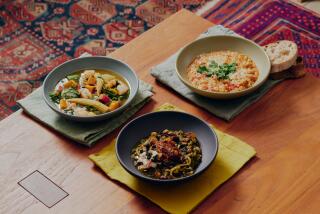The Squash in Winter
In summer, orange is the refreshing color of juice--translucent and quenching. In autumn, it’s the color of corn, falling leaves and a fat harvest moon slung low in the sky, glossy and glimmering. In winter, the color orange is deep and thick, like a stroke of artist’s oil slathered on with a palette knife, warm and comforting. It’s the color of long-roasted winter squashes intensified by slow cooking that softens the tough skin with its splattering of winter green, gray, white and orange.
Cooking winter squashes is a patient task, for ideally they want to be cooked in a dry-heat atmosphere. When you boil them, flavor, texture and color dilute. Even puree of squash soups have more flavor if you bake a whole squash until tender and then give it a briefer second cooking with onions and stock. Although it’s possible to add interest to the vegetable with butter and spices, the subtle (bland?) flavor of winter squashes is better coaxed by a slow cooking that breaks down the fibers, releases the water and concentrates the flesh.
Something indescribably creamy happens to squash when you keep it away from liquid until it softens. Boiled or steamed squash becomes soggy and thin-textured, a color orange that you can almost see through, more suited to a summer fruit than to a winter vegetable. The opaque orange color of a baked winter squash hints at the creamy mouth-feel of the vegetable and predicts the soothing flavor that is to come.
*
Similar magic is attained by chunks of peeled squash sweating in butter or oil in a heavy skillet. Cook, covered, either in the oven or on top of the stove. Remove the cover during the last 10 to 15 minutes to allow the vegetable’s moisture to escape. Grilling is one of the best methods, especially for slabs of banana squash. Improvise a cover and grill over coals that are not too hot. The squash takes on a smoky, caramelized flavor.
BANANA SQUASH IN CREAM WITH APPLES AND BACON
1 1/2 pounds banana squash
5 slices thick-cut bacon, cut into 1/2-inch pieces
1 tablespoon olive oil
1 tablespoon minced onion
1 teaspoon minced garlic
1 tablespoon unsalted butter
2 Granny Smith apples, peeled, cored and cut into 8 sections
1/4 cup whipping cream
Dash nutmeg
Salt, pepper
Use small knife or vegetable peeler to peel rind off squash. Cut squash into 1-inch cubes. Place squash, bacon, oil, onion and garlic in casserole or lidded baking dish. Bake, covered, at 375 degrees 40 minutes, stirring occasionally.
Meanwhile, heat butter in skillet over medium heat. Add apples and saute until golden, about 10 minutes. Remove skillet from heat and set aside.
When squash is tender, transfer mixture to skillet with apples. Place over medium-high heat. Add cream, nutmeg and salt and pepper to taste. Cook until cream thickens. Spoon into serving bowl and serve immediately. Makes 4 to 6 servings.
RAGOUT OF WINTER VEGETABLES
2 acorn squash
1 small celeriac, peeled and cut into 1-inch cubes
1 medium carrot, cut into 1-inch slices
1 medium onion, cut into 8 pieces
4 Brussels sprouts, trimmed, outer leaves discarded and sprouts cut into squares
2 teaspoons dried sage
1 teaspoon salt
1/2 teaspoon ground black pepper
1 tablespoon walnut oil
1 tablespoon flour
1/2 cup low-sodium chicken or vegetable broth
1 tablespoon unsalted butter
1 tablespoon sour cream
Pierce acorn squash with fork and place in baking dish. Bake at 375 degrees until tender when pierced with fork, about 45 minutes.
Meanwhile, combine celeriac, carrot, onion, Brussels sprouts, sage, salt, pepper and walnut oil in oven-proof skillet. Bake, covered, at 375 degrees 30 minutes. Stir in flour. Bake, uncovered, until vegetables are tender, about 10 minutes longer.
Transfer skillet to stove top. Add broth and cook over medium heat, stirring, until mixture thickens, about 2 minutes. Stir in butter. Remove from heat. Stir in sour cream.
Remove squash from oven. Halve lengthwise and scoop out seeds. To serve, arrange squash on plates, cut side up, and spoon vegetable ragout into squash halves. Makes 4 servings.
*
Succotash, from the Narragansett word for “ear of corn,” is a catch-as-catch-can recipe comprised of seasonal ingredients on hand. In summer, succotash was made with summer squashes, fresh beans and fresh young summer corn, much like the familiar succotash of corn and lima beans that we buy frozen or canned and that kids generally dislike. Winter versions were probably restricted to dried beans, dried peppers, winter squashes and gourds and dried corn. Serve warm tortillas instead of bread with this dinner soup.
WINTER SUCCOTASH
1/2 cup dried lima beans
1 tablespoon oil
1 medium onion, diced
2 cups fresh or canned low-sodium chicken stock
1 teaspoon dried thyme
1/2 teaspoon dried rosemary
1 teaspoon salt or to taste
1/2 teaspoon ground white pepper
1 cup canned hominy corn (posole)
1 medium butternut squash
1 tablespoon butter
Place lima beans in pan with water to cover and soak overnight.
When ready to cook, heat oil in pan. Add onion and cook, stirring occasionally, 5 minutes. Add stock, drained lima beans, thyme, rosemary, salt and white pepper. Cook, covered, over low heat 1 hour. Add hominy corn and cook until limas are tender, about 5 minutes longer.
While lima beans are cooking, pierce butternut squash in several places with fork and place on baking sheet. Bake at 375 degrees until tender when pierced with fork, about 1 hour.
Cut squash in half lengthwise. Discard seeds. Scoop out flesh and coarsely cut into medium chunks. Stir lima bean mixture into squash. Stir in butter. Adjust seasonings to taste. Makes 4 servings.
More to Read
Eat your way across L.A.
Get our weekly Tasting Notes newsletter for reviews, news and more.
You may occasionally receive promotional content from the Los Angeles Times.









